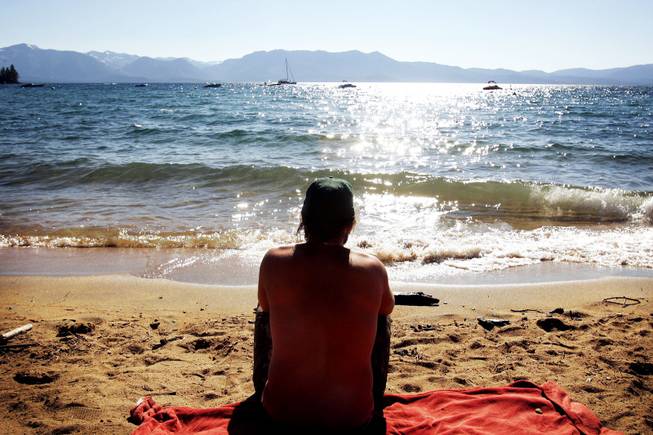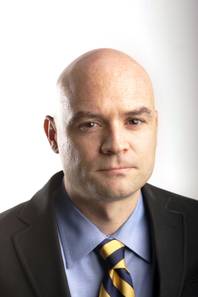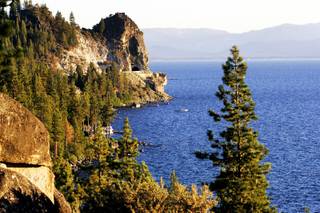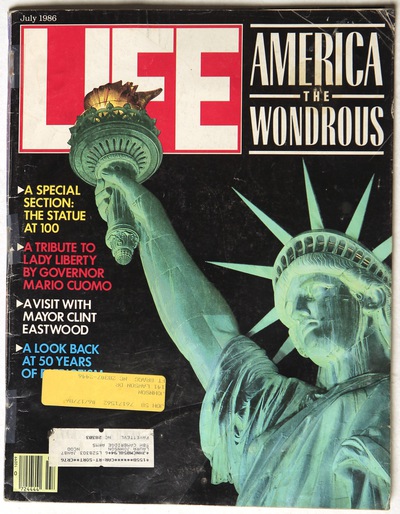
Lake Tahoe Basin, a National Forest Lands on the Nevada side of Lake Tahoe Wednesday, August 10, 2011.
Sunday, Aug. 21, 2011 | 2 a.m.

J. Patrick Coolican

Editor’s note: Twenty-five years ago this summer, Life magazine named U.S. Highway 50, as it crosses Central Nevada, the loneliest road in America. A photo of a straight stretch of empty highway fixed it in the national imagination as a symbol of the state’s vast emptiness. To mark the anniversary of the Life photo, columnist J. Patrick Coolican and photographer Leila Navidi drove the length of U.S. 50 in Nevada to examine issues important in the rural communities along the highway, meet its people and explore loneliness in the hyper-connected age.
STATELINE — We drive on U.S. Highway 50 toward Lake Tahoe, its surface shimmering with sunlight, the hillsides dense with trees.
I’m a little confused by all the hippies roaming about, until I realize that the jam band Phish is playing an amphitheater right on the lake. A guy with dreadlocks at a roulette table is a funny sight.
I sit outside the venue and hear a great “Antelope” to finish the first set.
A friend who lives nearby likes to boast that the lake is among the most beautiful places on the planet. And sitting lakeside on a summer night it’s hard to dispute that.
This great resource is under threat, however.
Last year, the famous clarity of Lake Tahoe declined from 68.1 feet in 2009 to 64.4 feet, the second-lowest measure of clarity on record, according to scientists at the UC Davis Tahoe Environmental Research Center. (They’ve been taking these readings for more than 40 years.)
Protecting this natural resource should be a top priority, but at the moment, it’s a tall order due to the lack of funds for environmental monitoring and mitigation, and political in-fighting at the lake that spilled over into the Nevada Legislature earlier this year.
The problem stems from the 1950s and 60s, when Californians did as Californians do — they built strip malls and service stations and shoddy apartments and other detritus of their suburban ethos. (OK, not entirely fair: Nevadans played a part, too.) The storm-water runoff from these aging projects is filled with nutrients, which feed algae, which kills lake clarity.
To do something about it, Republican governors of the two states came together and Congress ratified a compact that in 1969 created the Tahoe Regional Planning Agency.
The agency adopted environmental standards that have slowed the decline in lake clarity.
The agency has seven Nevadans and seven Californians, and project approvals require majorities of both states to agree. You can see how this would be unwieldy.
Developers and other business operators say there’s a whole crowd up here who doesn’t want a single nail hammered into anything, so they stand in the way of any plan to redevelop and rehabilitate these older properties that are the source of much of the pollution. At the Legislature, they succeeded in getting a bill passed and signed that will pull Nevada from the compact in a few years if a new regional plan isn’t adopted and changes aren’t made to the voting structure that would make it easier to get new projects approved.
It’s essentially legislative hostage-taking. But hey, whatever it takes. If the compact collapses, expect chaos.
Nevada Secretary of State Ross Miller, who sits on the board, says that with federal funds for cleanup drying up, we need to rely on the private sector to drive environmental protection. He envisions replacing those old strip malls and gas stations with new green, LEED-certified buildings.
The problem with that, however, is that reduction of stormwater, which is the real problem, is just a tiny part of getting a good LEED rating, according to Geoffrey Schladow, director of the UC Davis Tahoe Environmental Research Center.
Schladow isn’t entirely pessimistic, at least on the science, however. He says the total volume of algae hasn’t increased. Rather, he says, it’s of a different type — much smaller and therefore more likely to scatter light and reduce lake clarity. At the moment, there aren’t enough predators preying on this type of algae, but he expects over time one will emerge.
“Ecosystems adjust. When there’s too much prey, a predator rises up,” he says.
The other threat to clarity is global warming, if you believe in that sort of thing. The surface of the lake is warming. And warm water is lighter than cold, so the difference in density between the surface and the bottom is increasing, so you get less mixing. Less mixing is better for the smaller algae.
Schladow says we need a regional stormwater program of monitoring and mitigation.
Scot Rutledge of the Nevada Conservation League says the hostile new law was over-the-top, but he concedes it’s spurred some action, especially on a new regional plan that is now years overdue.
“I do believe business leaders at the lake are supportive of (the agency) and the work they’re doing, and I believe a regional plan can and will be developed,” he says.
I generally wouldn’t trust a bunch of developers when it comes to protecting the environment, but this case is clearly different because the natural beauty of the region is the whole reason everyone goes there. So even casino companies I wouldn’t normally equate with environmental protection have a vested interest in protecting the lake.
Get together people, and fix this.
It’s an awesome resource. And when the Southern Nevada Water Authority decides we need to build a pipeline there to drain it for unchecked sprawl down here, we’ll need that water to be clean.



Join the Discussion:
Check this out for a full explanation of our conversion to the LiveFyre commenting system and instructions on how to sign up for an account.
Full comments policy